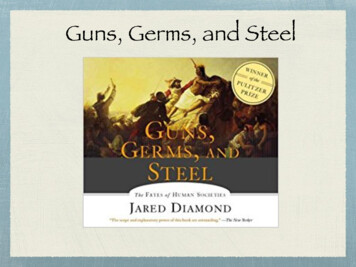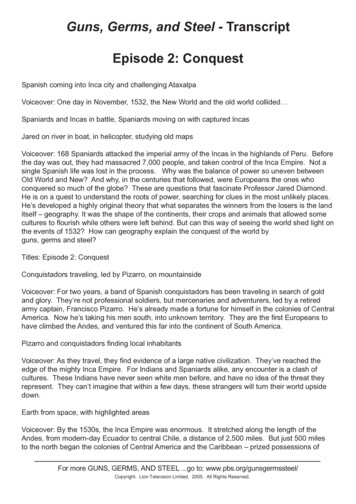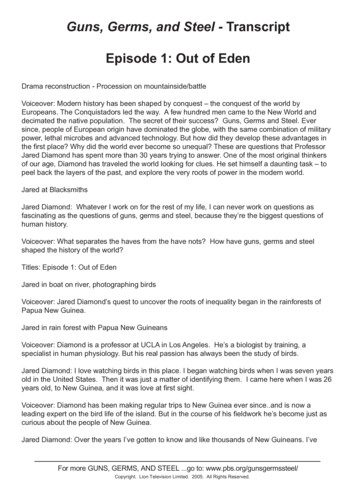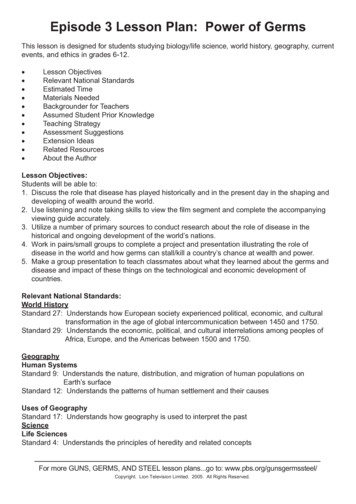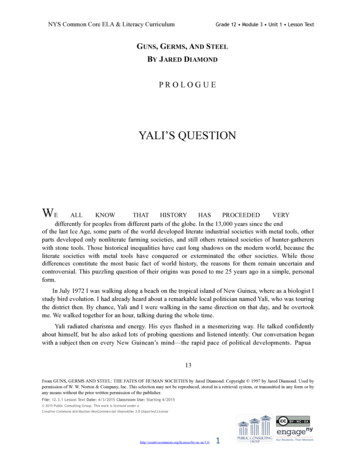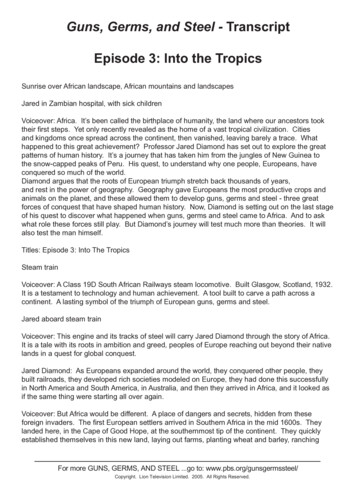
Transcription
Guns, Germs, and Steel - TranscriptEpisode 3: Into the TropicsSunrise over African landscape, African mountains and landscapesJared in Zambian hospital, with sick childrenVoiceover: Africa. It’s been called the birthplace of humanity, the land where our ancestors tooktheir first steps. Yet only recently revealed as the home of a vast tropical civilization. Citiesand kingdoms once spread across the continent, then vanished, leaving barely a trace. Whathappened to this great achievement? Professor Jared Diamond has set out to explore the greatpatterns of human history. It’s a journey that has taken him from the jungles of New Guinea tothe snow-capped peaks of Peru. His quest, to understand why one people, Europeans, haveconquered so much of the world.Diamond argues that the roots of European triumph stretch back thousands of years,and rest in the power of geography. Geography gave Europeans the most productive crops andanimals on the planet, and these allowed them to develop guns, germs and steel - three greatforces of conquest that have shaped human history. Now, Diamond is setting out on the last stageof his quest to discover what happened when guns, germs and steel came to Africa. And to askwhat role these forces still play. But Diamond’s journey will test much more than theories. It willalso test the man himself.Titles: Episode 3: Into The TropicsSteam trainVoiceover: A Class 19D South African Railways steam locomotive. Built Glasgow, Scotland, 1932.It is a testament to technology and human achievement. A tool built to carve a path across acontinent. A lasting symbol of the triumph of European guns, germs and steel.Jared aboard steam trainVoiceover: This engine and its tracks of steel will carry Jared Diamond through the story of Africa.It is a tale with its roots in ambition and greed, peoples of Europe reaching out beyond their nativelands in a quest for global conquest.Jared Diamond: As Europeans expanded around the world, they conquered other people, theybuilt railroads, they developed rich societies modeled on Europe, they had done this successfullyin North America and South America, in Australia, and then they arrived in Africa, and it looked asif the same thing were starting all over again.Voiceover: But Africa would be different. A place of dangers and secrets, hidden from theseforeign invaders. The first European settlers arrived in Southern Africa in the mid 1600s. Theylanded here, in the Cape of Good Hope, at the southernmost tip of the continent. They quicklyestablished themselves in this new land, laying out farms, planting wheat and barley, ranchingFor more GUNS, GERMS, AND STEEL .go to: www.pbs.org/gunsgermssteel/Copyright. Lion Television Limited. 2005. All Rights Reserved.
cattle and sheep.African landscape with trainJared Diamond: This may sound strange but it’s from ordinary agriculture like this that my theoryof guns, germs and steel arose. My quest began more than 30 years ago, on a trip to PapuaNew Guinea, when I began to try to understand why the people there lived so differently fromEuropeans and Americans. The beginnings of the answer, I realized, depended on farming. NewGuineans had only a few native crops that they could grow, and no native farm animals, while myancestors, even 10,000 years ago, had been blessed with an abundance of domestic plants andanimals. Over the centuries this had given them a huge advantage that let them develop cities,nations and even colonies abroad.Voiceover: But Southern Africa is 5,000 miles from Europe. How was it possible for the settlersto import European crops and animals to such a distant part of the world? As much as skill, itcame down to good fortune. Geography had dealt the settlers an immensely lucky hand. Theyhad stumbled across one of the few parts of the southern hemisphere that feels just like Europe.Because the Cape and Europe lie at a similar latitude, or distance from the equator, and thismeans that the temperature and climate of these widely separated regions are almost exactly thesame. The Europeans were able to establish prosperous farms and settlements, properties nowowned by their descendants – people like Hempies Du Toit.Jared Diamond: So your family has been here for centuries on this land. How do you feel aboutthe land yourself then?Hempies Du Toit, Annandale Farm, South Africa: Well I’ve always loved the land since childhooddays and it comes, agriculture’s been in our family for so many generations.Jared Diamond: Tell me about the history of this farm.Hempies Du Toit: Well the, the land was occupied in 1683, I mean that was only a couple of yearsafter the first settlers came to the Cape.Voiceover: But settlers like the Du Toit knew that this was not an empty land. Even today theirfarms turn up evidence of the Cape’s original inhabitants, a people known as the Koysan.Hempies Du Toit: Oh this is interesting. This is a, this is from the Stone Age. Prior to theoccupation of this land in 1683 by the settlers, this land was most probably occupied by Koysanpeople. These were the tools they used to, to scrape the skins when they tanned the skins.Jared Diamond: Beautiful.Hempies Du Toit: And you can see how easily, how nicely it fits into your hand.Jared Diamond: Yeah.Voiceover: With the arrival of Europeans, these native peoples were driven from their land. Butthey also faced an invisible and even more devastating agent of conquest. A force Diamond hasidentified as one of the greatest in human history – germs.For more GUNS, GERMS, AND STEEL .go to: www.pbs.org/gunsgermssteel/Copyright. Lion Television Limited. 2005. All Rights Reserved.
Jared Diamond: Realizing the importance of farming led me to the next big surprising discoveryof guns, germs and steel. Domesticated animals had given Europeans one advantage of whichthey were completely unaware. By living in close proximity to their livestock, they had becomeinfected with viruses and germs of those animals, which evolved into diseases of humans.Through exposure over centuries, Europeans had developed some resistance to those diseases.But as Europeans spread around the world, they encountered peoples who didn’t have that sameresistance, and who then fell victim to devastating outbreaks of infection, especially of smallpox.In the Americas, millions of native people died from this one disease, and here in the Cape itwrought the same havoc on the Koysan peoples.Voiceover: Through their farming and their germs, Europeans had established a firm foothold inthe southern tip of Africa. Now, they looked to expand.Jared Diamond: In the 1830s there was a burst of the pioneer spirit such as had been seen inthe European expansion across North America and Australia. This time it was Dutch settlers,and these pioneers moved into the interior like the pioneers moving across North America andAustralia.Voiceover: Over the course of the 1830s, thousands of Dutch farmers with their families andpossessions loaded into wagons left the Cape in search of new land to settle. They calledthemselves the voertrekkers, and these pioneers all wielded another agent of European conquest– the gun.Paul Garner, Battlefield Historian: This is a muzzle-loading rifle, typical of the weapon that everyVoertrekker would have had in his wagon. The Boers were particularly adept at using thisweapon.Voiceover: They could reload it and fire from horseback. These muzzle-loading rifles are still muchadmired by the voertrekkers’ descendants.Derek Engelbrecht, Settler Descendant: Every single man that was in, in good health had at leasttwo or three of these particular rifles.Posselt Lawrens, Settler Descendant: In those days it must have been the person’s life, you know.Everything depended on that, you know.Derek Engelbrecht: They hunted with them, they protected themselves with them.Posselt Lawrens: It was part of him, you know, if you didn’t handle a gun in that day there wassomething wrong with you. Yeah.Man firing gun and Jared watching and firing it himselfJared Diamond: Guns and the steel from which they’re made were the last two of the greatadvantages that Europeans carried with them around the globe.Sword smith working as Jared watchesJared Diamond: Guns are the result of thousands of years of complex technologicaldevelopments, which began outside Europe but which Europeans perfected.For more GUNS, GERMS, AND STEEL.go to: www.pbs.org/gunsgermssteel/Copyright. Lion Television Limited. 2005. All Rights Reserved.
And that was all because of the head start that their farming had given them thousands of yearspreviously.Derek Engelbrecht: You know, the flintlock rifle, it was, you know, I shouldn’t reallysay this but it was nearly like as important as a cellphone is today. You can’t go without yourcellphone; in those days you couldn’t go without your flintlock rifle.Fire, with settlers tending it and in encampment at nightVoiceover: Armed as they were, the European settlers must have been confident they couldovercome any obstacle as they pushed further into the African interior. By February 17th 1838,the voertrekkers had reached 800 miles inland from the Cape. But they were entering an alienand unexplored land.Zulus approaching settlers’ encampment and attacking it, leaving camp burningVoiceover: Suddenly out of the darkness swept a native African army. Their victims barely hadtime to fire a single shot from their rifles before they were completely overwhelmed. Within hours,nearly 300 voertrekkers lay dead.Child crying in camp at morning as settlers lie deadVoiceover: Their enemy had struck without mercy. Killing men, women and children alike. Whocould have committed such a ruthless and calculated assault, stopping the Europeans in theirtracks? In fact, the voertrekkers had trespassed across the border of a mighty African kingdom.Inhabited by people very different from the Koysan of the Cape. They had encountered the Zulus.Paul Garner: When they ran into the Zulus, they ran into a group of people who were verydifferent to anybody else they’d been up to, up against up until that point in time. This was anorganized group of people.Archive: B&W still – Zulu warriorsVoiceover: The Zulus were the authors of a unique and highly developed African state. Theirmilitary skills had allowed them to overwhelm their native African neighbors.They held more than 30,000 square miles of land, and had established a sophisticated economyand society. The ferocity of the Zulu defense of their land was something the voertrekkers hadsimply not expected.Paul Garner: It was more than the voers could handle. They, they, they were not prepared for theattack from the Zulus. They were up against a king who could mobilize an army of 10-15,000 menwithout any problem at all. It could take on almost anybody, they were absolutely fearless.Voiceover: The voertrekkers were stunned and devastated. Had they, and the power of guns,germs and steel met their match in Africa? The voertrekkers showed little interest in who theZulus were, or how they’d developed such a sophisticated state. They wanted a showdown. Theygathered their scattered forces behind a great circle of wagons, and readied themselves for battle.At dawn on 16th December 1838, more than 10,000 Zulus stormed across the horizon, chargingin to destroy the outnumbered settlers. But this time, the Europeans were able to use theirtechnology to maximum effect. To increase the rate of fire from their muzzle-loading rifles, somewould shoot while others would reload.For more GUNS, GERMS, AND STEEL .go to: www.pbs.org/gunsgermssteel/Copyright. Lion Television Limited. 2005. All Rights Reserved.
Derek Engelbrecht: They would shoot, hand the gun over, take the next gun, fire, hand the gunover. So every five or six seconds you could fire a shot. See that, that was the important thing.Voiceover: This time, not a single Zulu could get within ten paces of the encampment. It was amassacre.Paul Garner: The voertrekkers had probably killed an estimated 3-3,500 Zulus. The Boersthemselves suffered only three injuries.Voiceover: The conflict became known as the Battle of Blood River. The Zulus had been broken.Guns, germs and steel had prevailed.Steam train being stoked, Jared studying on trainJared Diamond: The victorious European settlers pushed on beyond Zulu lands, while newdevelopments in their technology let them increase the pace of conquest. Railroads were key.With railroads one could transport lots of people and their supplies over vast areas. And so inAfrica, Europeans started to build railroads, move into the interior and transport themselves andtheir supplies.Voiceover: This was the era of the industrial revolution, a revolution that introduced one furtherweapon to the colonization of Africa. A weapon that put the same devastating firepower seen atBlood River into the hands of just a single man.Paul Garner: This is a Maxim gun. What made this weapon such a great weapon, as opposed tothe old single-shot weapons that had been used in years before, is this gun could fire continuouslyfor up to 500 rounds a minute. It had the equivalent firepower of probably 100 men in a companywith single shot weapons.Voiceover: As they drove further into Africa, Europeans encountered new tribes, some just ashostile to invasion as the Zulus had been. But for peoples like the Matabele, there was simply noanswer to the world’s first fully-automatic weapon. The Matabele conflict of October 1893 lasted amatter of hours.Paul Garner: The settlers mowed down those Matabele warriors until there were only a few ofthem left. It was a real case of ancient technology up against the latest and greatest as far asEuropean inventions were concerned.Jared Diamond: It seems like the birth of a new age. Europeans carving the path into theinterior of Africa. Conquering tribe after tribe, settling where they pleased. Guns, germs and steeltriumphant. Except now, those settlers would find themselves facing an entirely new enemy – onethat had once been their greatest ally. Geography.Voiceover: As they moved north, settlers cleared land for farms, confident they could build aprosperous life in Africa. But with little warning, things began to go awry. The land becameimpossible to plough. Their crops refused to grow. Their shoes fell apart in the mud. And thatwas only the start.For more GUNS, GERMS, AND STEEL .go to: www.pbs.org/gunsgermssteel/Copyright. Lion Television Limited. 2005. All Rights Reserved.
Jared Diamond: The second big problem that Europeans encountered was their animals died.Their horses and oxen had been a big part of the European advantage elsewhere in the world– oxen as draught animals, and horses as their military animals, but here their animals were dying.Voiceover: For thousands of years, these domesticated animals and crops had sustainedEuropean civilization. Without them, there would have been no guns, germs and steel; no historyof conquest and colonization. And now the settlers themselves began to fall ill with terrible fevers,while all around them they could see native Africans farming, herding cattle, healthy and alive.How was this possible? What were the secrets of this strange new land?Jared Diamond: The ideas behind guns, germs and steel all spring from an understanding ofgeography. And geography explains why Europeans were now failing.Voiceover: European crops had grown well in the Cape, because the Cape was a mirror ofthe European world, lying on a similar latitude. But as the settlers progressed into the Africaninterior, they’d been moving north, closer and closer to the Equator. At about 23 degrees south,near the River Limpopo, they passed a major geographical boundary known as the Tropic ofCapricorn. They were leaving behind their familiar European climate and entering a totallydifferent world. They had entered the Tropics. Compared to the European or temperate zones,the Tropics operate by entirely different rules. Instead of the four seasons of Europe, NorthAmerica and the Cape, here there are just two – the dry season, and the rainy. Wheat andbarley, the crops that had sustained European civilization for centuries, had not evolved to survivein this tropical climate. Yet the native Africans, the Zulus, the Matabele, all the tribes that thesettlers had encountered, depended on agriculture just as much as the Europeans. How werethey succeeding as the Europeans failed? Even today, the continent of Africa is composed ofthousands of different tribal groupings. Each is subtly distinct from the next, in custom andlanguage.Children singing in classroom as Jared watchesJared Diamond: Such diversity means that most Africans have to master more than one language,and they acquire those skills at a very young age.Jared asking children about the languages they speakJared Diamond: I would like to find out how many languages you speak. Who here speaks, knowshow to speak Bemba? Aha. Does anybody else know how to understand or speak Lozi? Youspeak Lozi.Child: Yes.Jared Diamond: Do you also speak Bemba?Child: Yes.Jared Diamond: Is there another language that you speak also?Child: Lovak.For more GUNS, GERMS, AND STEEL .go to: www.pbs.org/gunsgermssteel/Copyright. Lion Television Limited. 2005. All Rights Reserved.
Jared Diamond: Lovak. That’s four languages. That’s good. Most Americans speak only onelanguage. After a little exposure to these different languages, you begin to realise one thing – theyall sound remarkably similar. I’m fascinated with languages, and wherever I’ve been going I’masking Africans, what’s your language and tell me some words in your language, so here’s what Ifound out for the word for sun. In the Neanga language, sun is azuba, in the Bemba language it’shaka zuba, in Chiwa it’s dzuba, and in the Senga languages, zuba again. Or the word for water.In the Neanga language it’s manzi and in Bemba it’s amenchi, and in chiwa it’s manzi, similar toeach other again.Marketplace with people buying and sellingJared Diamond: What do these linguistic similarities tell us? That there is a common root for mostof the modern languages of tropical Africa. A single ancestral language spoken by a single groupof people from which the many languages of today have descended.Voiceover: Linguistic analysis has isolated a family of languages known as Bantu, which originatedin tropical West Africa. About 5,000 years ago, the early Bantu speakers began to spread intonew lands, bringing their crops, their animals and their language with them. And over centuries,Bantu culture evolved, diversifying into hundreds of tribes, expanding across the tropical regionof Africa. But the truth of this pan-African civilisation was suppressed for many years. Dr AlexSchoeman is trying to overturn the legacy of South Africa’s racist past. She has been excavatingan archaeological site on the banks of the Limpopo River.Alex Schoeman, University of the Witwatersrand, South Africa: In the early part of the 20thcentury, and there were rumors in the white South African community about this place, in theirminds linked to the Queen of Sheba or some other early white civilization in Southern Africa, tryingto show that the Phoenicians or the Subeyans, basically anybody who was a bit lighter-skinnedthan Africans, were here first, and they found the opposite, that Africans actually had amazinggreat history and that they had earlier states running before, way before any white set foot inAfrica.Voiceover: This site, known as Mapungudwe, the place of the jackal, formed the heart of akingdom similar to the earliest civilizations in Europe.Alex Schoeman: Mapungudwe was the core, it was the capital of a massive state, and about 5,000people living around this hill, but then you had several thousand other people living in the valleywho produced the agricultural surplus to feed the city or town. They had cattle, they had sheep,they grew sorghum, millet, and they worked iron. It wasa massive, amazing development that occurred in Southern Africa.Voiceover: And this was not an isolated state. It formed part of a much larger economic networkthat had spread across Southern Africa and beyond.Alex Schoeman: These are Mapungudwe beads, they’re gorgeous blue ones, these are glassbeads that came down the Indian Ocean coast, and through them we know that Mapungudwe’spart of an international trade network, linking it all the way to the coast. It’s an incredible Africanaccomplishment, to set up such a complex trade network that links all the way into NorthernBotswana, bringing material from there and taking it all the way to the Indian Ocean coast.Early African farmersFor more GUNS, GERMS, AND STEEL .go to: www.pbs.org/gunsgermssteel/Copyright. Lion Television Limited. 2005. All Rights Reserved.
Jared Diamond: So, Africans had overcome the problems of agriculture that defeatedthe European settlers. They had developed a unique tropical system of agriculture that hadspread across the continent, and become the foundation of complex societies, trading as far afieldas India. But there was an even more extraordinary story at the heart of this flourishing tropicalcivilization.Voiceover: As soon as they entered the tropics, Europeans and their imported animals had fallenvictim to terrible disease. Fevers wracked their population. Yet tropical Africans showed fewer ofthe same effects. Many of them even survived that most lethal of European weapons; smallpox the disease that had devastated the native peoples of North and South America and the Koysan ofthe African Cape. How was this possible?Diamond believes it all comes back to geography. Many of the diseases that were killingthe settlers and their European livestock were unique to the tropical world. They had neverencountered them before. It was a complete reversal of the usual pattern of conquest.Jared Diamond: In the New World, the germs had been a weapon on the side of the Europeanskilling indigenous people. Here it was indigenous germs, to which Europeans had not a historyof exposure, and so here we have guns germs and steel again, but the germs working in theopposite direction, killing Europeans.The settlers and their imported livestock had fallen victimto a host of tropical infections and diseases. But African cattle, over thousands of years, haddeveloped resistance to many of these tropical germs. And these cattle might also explain whytropical Africans had not succumbed to smallpox on the same scale as the Koysan people of theCape. The smallpox virus originally crossed over from cattle to man centuries ago, and expertsnow believe it may have first originated in tropical Africa. Africans were certainly familiar with thedisease. They had even developed methods of vaccination that bestowed immunity for life. Andthere was more. Native Africans had also developed antibodies against one of the most virulentdiseases on earth. Malaria. Carried by the humble mosquito, this was the disease that was nowoverwhelming the European settlers. But tropical Africans were combating malaria with more thanjust antibodies. Their entire civilisation had evolved to help them avoid infection in the first place.They tended to settle in high or dry locations, away from the wet, humid areas where mosquitoesbreed. And by living in relatively small communities, spread out over vast areas, Africans couldlimit the level of malaria transmission. It was an extraordinary achievement. But the Europeansunderstood little of the Africans’ way of life. They built settlements by the rivers and lakes theyused for water, in places infested by mosquitoes. Thousands died.Jared Diamond: So it seemed that the tropics had defeated European guns, germs and steel. Andthat Africans had emerged triumphant. They had evolved a complex civilization well suited to thetropical world. A civilization that had spread throughout the continent in a vast cultural Diaspora.Voiceover: Was this the end of European guns, germs and steel in Africa? What would the futurehold for this mighty tropical civilization? The Europeans had failed to settle Africa’s land. Thiswould become no North or South America. But Africa still hadone great draw for the colonizing powers – vast reserves of natural resources; copper; diamonds;gold. European conquest and the story of guns, germs and steel would now enter a whole newage.Archive: B&W footage Africans laboring and buildingVoiceover: In the late 1800s, is what is now the Democratic Republic of the Congo, the BelgiansFor more GUNS, GERMS, AND STEEL .go to: www.pbs.org/gunsgermssteel/Copyright. Lion Television Limited. 2005. All Rights Reserved.
drove millions of native Africans from their villages, setting them to work gathering rubber, miningcopper and other minerals. Burning their homes behind them. Reducing their 1,000 yearold tropical civilization to dust and ashes. Few were as brutal as the Belgians, but across thecontinent, millions of Africans were compelled to abandon a way of life perfectly adapted to thetropics, and to labor for Europeans. To ferry Africa’s natural wealth back to Europe, the colonizersturned again to their technology, building ever greater railroads. After more than half a century andthe labor of tens of thousands, tracks of shining steel reached all the way from the Cape into thevery heart of the tropics. Constructed for Europeans to extract Africa’s wealth. Built on the ruins ofAfrican civilization.Jared Diamond: All this time, I’ve been uncovering the train of guns, germs and steel acrossAfrica. And even this train and the track it rides on lie at the heart of my story.These tracks are still in use, still fulfilling their original purpose. Trains travel from the southerntip of Africa into modern Congo and Zambia, ferrying back tons of copper and other minerals.But Africa today is no longer a continent of colonies. Its nations are free and independent. Whatplace is there for my theory of guns, germs and steel in modern Africa?Voiceover: The end of the line for Jared Diamond. Civil war in the neighboring Congo makes it toodangerous to travel the last few miles of this track. But even here, the reality of modern Africa isclear.Jared Diamond: I’m now in the centre of the African tropics, and I’m in Zambia, one of thepoorest countries in Africa and really in the whole world. The average annual income here is afew hundred dollars, and the lifespan, average lifespan of a Zambian is 35 years, so I myself havenow lived nearly two average Zambian lifetimes. What goes through my mind here is, what canhistory and geography and guns, germs and steel tell us that would help us understand the plightof Zambia today? In modern Zambia I see few signs around me of the great native civilizationsthat once flourished in tropical Africa. What I see instead is a country shaped by colonization. Isee towns and cities that grew up next to the mines and railroads established by Europeans, andbuilt on the European model. What about the great forces that originally shaped this continent andits people? The forces behind its conquest by Europeans. Where are guns, germs and steel inmodern Africa?Hospital interior with patients and familiesDr Christine Manyando, Tropical Diseases Research Centre, Zambia: In Zambia, malariais endemic. It is the number one public health problem, and when you look at the childrenparticularly, when you go to a health facility, up to 45% of the children in the outpatient facility ofthe hospital will actually be presenting with malaria.Hospital with patients and their parentsCoffin shop exteriorVoiceover: Germs, one of Diamond’s great forces of history, are still shaping the story of modernZambia. Not just the recent scourge of AIDS, but also that ancient tropical disease that defeatedEuropeans – malaria. Malaria is now the number one killer of African children under five years old.Christine Manyando: This old register will just show you the picture of, of the number of deathsthat would have occurred within the hospital. Most of them are children below five years, one yearFor more GUNS, GERMS, AND STEEL .go to: www.pbs.org/gunsgermssteel/Copyright. Lion Television Limited. 2005. All Rights Reserved.
six months, three years, five months, one year, most of them are really below five years.Voiceover: Tropical Africans once lived in settlements spread out over large areas, whichminimised the spread of malaria. But now they’re living in modern high-density cities and towns,and the rate of infection has increased dramatically. The burden of germs is one of the greatestproblems afflicting the country.Christine Manyando: Undoubtedly malaria has a very big economic burden on us as a country,because as you may be aware, if so many children would be suffering from malaria, if we justlook at the children who are in this ward, these mothers would be working somewhere and beingproductive, so that’s one direct way in which we know productivity’s been affected to a largeextent.Professor Nick White, Centre for Tropical Medicine, Oxford University: It’s been estimated byeminent economists that the 1% negative growth each year in Africa over the last half a centurycan be attributed entirely to malaria.Voiceover: The immunities and antibodies that Africans had developed over thousands of yearsto protect them from malaria no longer provide sufficient protection. The strains of the diseaseare mutating, and standard drugs are becoming less effective. In the high malaria season, up toseven children a day die in this hospital.Jared Diamond: You’re used to this. I’m, I’m not. I’m – what is this, what does this scene makeyou feel about – your work in Zambia?Christine Manyando: Exactly. To be frank with you, Jared, I wouldn’t say I’m used to this, becauseI don’t think there’s anyone who can be used to sickness and eventually death, especially ofpeople that you love so very much and are a part of you. It is, it is something that in fact I wouldsay because of the magnitude of the problem, one would wish to do everything they possibly coulddo.
continent. A lasting symbol of the triumph of European guns, germs and steel. Jared aboard steam train Voiceover: This engine and its tracks of steel will carry Jared Diamond through the story of Africa. It is a tale with its roots in ambition and greed, peoples of Europe reaching out beyond their native lands in a quest for global conquest.
